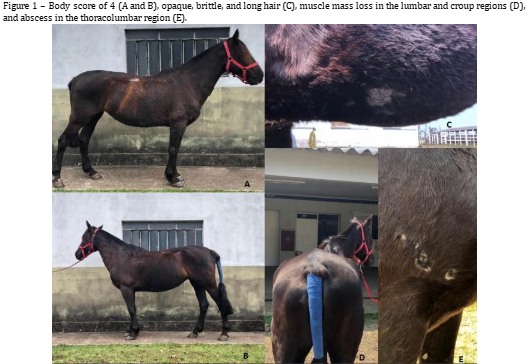Pituitary pars intermedia dysfunction (Cushing’s syndrome) associated with pituitary adenoma in a mare
DOI :
https://doi.org/10.21708/avb.2024.18.4.12542Résumé
Pituitary pars intermedia dysfunction (PPID), also known as Cushing’s syndrome (CS) or hyperadrenocorticism, is a condition characterized by loss of dopaminergic inhibition of the pituitary pars intermedia. A Crioulo mare was presented with progressive weight loss, incoordination when walking, polydipsia, and a coat with a hirsute appearance. Loss of tail tone and muscle mass in the lumbar and gluteal regions, as well as long hair with a hirsute, opaque, and brittle appearance, were observed on inspection. In addition, the mare had small abscesses in the thoracolumbar region, and there were no other abnormalities on physical examination. The low-dose dexamethasone suppression test (DST) was performed to confirm the suspicion of CS, demonstrating a level of 4.6 µg/dL higher than baseline after 19h, confirming the diagnosis of PPID. The treatment consisted of cyproheptadine, and the animal showed improvement, being discharged from the hospital after 10 days. Continuation of the treatment was recommended on the farm. According to the veterinarian on the farm, the animal had been showing improvement, but it developed respiratory complications 10 days after discharge and died three days later. The main findings of the necropsy included severe diffuse granulomatous pneumonia, in addition to pituitary pars intermedia adenoma, which confirmed the clinical suspicion of PPID.
Téléchargements

Téléchargements
Publié-e
Numéro
Rubrique
Licence
(c) Tous droits réservés Acta Veterinaria Brasilica 2024

Cette œuvre est sous licence Creative Commons Attribution 4.0 International.
Autores que publicam na Acta Veterinaria Brasilica concordam com os seguintes termos: a) Autores mantém os direitos autorais e concedem à revista o direito de primeira publicação, com o trabalho simultaneamente licenciado sob a Licença Creative Commons Attribution que permite o compartilhamento do trabalho com reconhecimento da autoria e publicação inicial nesta revista. b) Autores têm autorização para assumir contratos adicionais separadamente, para distribuição não-exclusiva da versão do trabalho publicada nesta revista (ex.: publicar em repositório institucional ou como capítulo de livro), com reconhecimento de autoria e publicação inicial nesta revista. c) Autores têm permissão e são estimulados a publicar e distribuir seu trabalho online (ex.: em repositórios institucionais ou na sua página pessoal) a qualquer ponto antes ou durante o processo editorial, já que isso pode gerar alterações produtivas, bem como aumentar o impacto e a citação do trabalho publicado (Veja O Efeito do Acesso Livre).


 Esta obra está licenciada com uma Licença
Esta obra está licenciada com uma Licença 